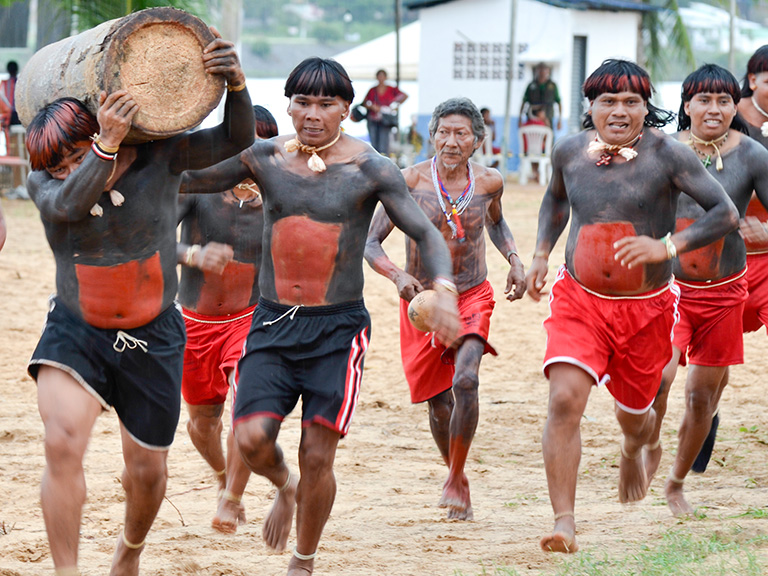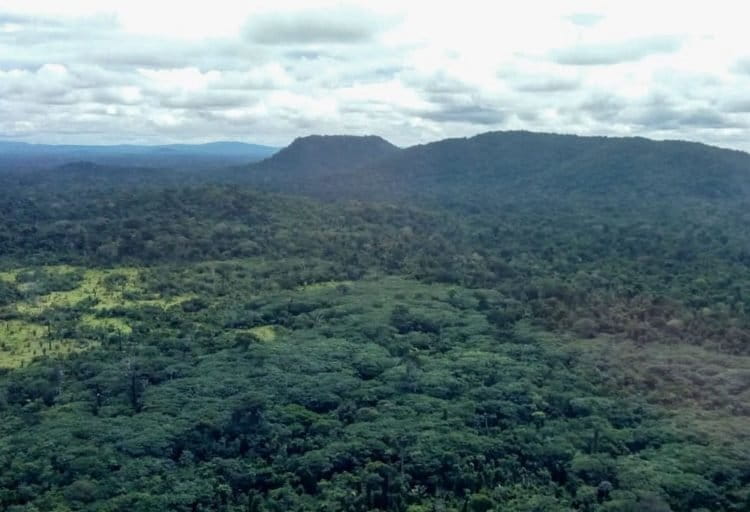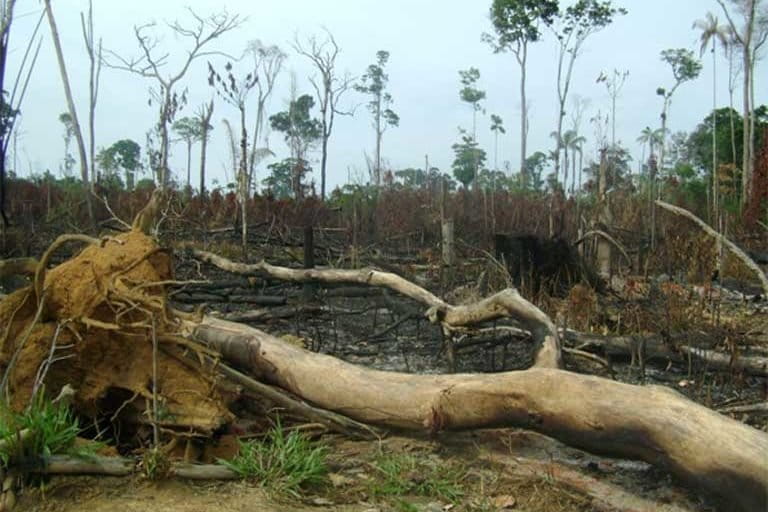- 537 COVID-19 cases and 102 deaths are being reported by 38 indigenous groups in Brazil. Most of the cases are in the remote Brazilian Amazon, where communities are located far from medical assistance. Experts, citing the vulnerability of indigenous peoples to outside disease, worry the pandemic could result in a many more deaths.
- In response to the pandemic, indigenous groups in Mato Grosso state have partnered with an NGO to produce a daily updated map monitoring COVID-19 outbreaks in urban areas near indigenous villages. The website is meant to keep indigenous people informed, and put pressure on national and international groups to respond.
- Amid the pandemic, indigenous land rights in Mato Grosso are increasingly threatened by federal and state government policy shifts that critics say would encourage and legitimize land grabbing, illegal logging and mining inside indigenous territories.
- Particularly impacted by the policy changes, should they go into effect, are isolated indigenous groups, including the Kawahiva and Piripkura peoples who roam as yet federally unrecognized indigenous reserves near the city of Colniza, Mato Grosso.

Indigenous groups in Brazil are reeling from COVID-19 as infections and the death toll rise, with 540 cases and 103 deaths among 38 ethnic groups now reported by Brazil’s Indigenous Peoples’ Articulation (APIB).
APIB says that the real numbers are likely much higher due to notification delays and underreporting.
Worst hit is Amazonas state which has recorded 78 indigenous deaths, and its capital, the rainforest metropolis Manaus, where officials say the health system has collapsed.
Messias Kokama, leader of Parque das Tribos, an indigenous community on the outskirts of Manaus was buried last week.
Now, the disease is spreading into the vast state’s far-flung and underserved interior towns, further endangering indigenous communities.
So far, Brazil is the hardest hit country by COVID-19 in South America. Cases are increasing by 10-15 thousand per day and as of Monday there had been more than 16,000 deaths.
President Jair Bolsonaro’s handling of the pandemic has been widely decried as among the world’s worst. A second health minister left the government Friday due to disagreements over social distancing and use of the drug chloroquine — which new studies show has no effect on the disease.
Meanwhile, reports suggest loggers, illegal miners and land grabbers may be taking advantage of the chaos brought by COVID-19, invading indigenous lands, amid falling environmental oversight.

COVID-19 mapping in Mato Grosso
In response to the pandemic, indigenous groups in Mato Grosso state in Brazil’s agribusiness heartland have partnered with a local NGO to produce a map that monitors COVID-19’s spread in towns and cities close to indigenous communities.
The online COVID-19 map comes as local advocacy groups in Mato Grosso condemn regulatory attacks on indigenous land rights by both state and federal governments.
The digital map — developed by NGO Life Centre Institute (ICV) in partnership with Mato Grosso’s Indigenous Peoples Federation (FEPOIMT) — provides daily updates of the number of COVID-19 cases near indigenous lands.
“It’s a very valuable initiative,” Crisanto Xavante, president of FEPOIMT, said of the map. “This virus is the invisible enemy of mankind.”
Crisanto told Mongabay that as well as alerting communities to the encroaching danger of the virus, the map also serves as a tool with which to appeal to authorities and organizations to provide more resources.
“We know from experience that we are not a priority of the government,” Xavante said.
Many indigenous people in Mato Grosso, and across Brazil, make regular trips to the nearest town or city to buy food and other supplies or to collect government benefits, increasing infection risk.
The first case of indigenous infection in Mato Grosso was recorded last weekend, with a tribeswoman from the Xavante ethnic group hospitalized. According to the digital map, dozens of cases have been confirmed in cities that border indigenous lands.
Several cases have been recorded in towns near the 26,000 square kilometer (10,039 square mile) Xingu National Park reserve, where savanna meets Amazon rainforest, home to 6,000 indigenous people from 16 different groups.
There, villages have been in lockdown since late March which has complicated traditional community agricultural cycles, as tools and supplies have been harder to access, leaders said.
“We know that the danger is getting closer,” Ianukula Kaiabi Suia, president of the Xingu Indigenous Land Association (ATIX) told Mongabay.
“What concerns us is that the state doesn’t have sufficient [healthcare] infrastructure,” he added, noting that the majority of Mato Grosso’s intensive care beds are located in the capital Cuiabá, over 500 kilometers (310 miles) distant.

Land threats
Mato Grosso is home to around 50,000 indigenous people from 43 different groups, the sixth biggest indigenous population in Brazil’s 27 states, according to the country’s geography and statistics institute (IBGE).
The state is also Brazil’s agribusiness powerhouse, being its top producer of grains including soy and corn, and boasting 30 million cattle — ten times Mato Grosso’s human population.
Politicians representing Mato Grosso’s agricultural sector have long sought to reduce, overturn or halt the creation of indigenous reserves in the state, efforts that have only accelerated under President Jair Bolsonaro, experts say.
Several of the state’s indigenous lands were among the worst affected by last year’s Amazon fires, according to data from Brazil’s Social Environmental Institute, a prominent NGO. A scientific study found that many of the Amazon’s 2019 fires were directly linked to deforestation, likely carried out by land grabbers.
Now, advocacy groups are rallying against a recently proposed state land regularization bill, an amendment of which allows for rural property registration claims by outsiders within Mato Grosso’s thirteen indigenous lands that are still awaiting official recognition.
Critics say the amendment rewards large-scale land grabbers, especially those who have illegally occupied indigenous lands, and that the new rules would lead to further invasions, increasing risk of conflicts and COVID-19 infections.
Lúdio Cabral, a Mato Grosso state legislator with the Worker’s Party (PT), told Mongabay interested parties were “taking advantage of the dramatic situation of the pandemic, under the pretext of simplifying land claims for smallholders.”
In a statement, Mato Grosso’s State Environment Secretariat countered that view, saying that the amendment would allow for better surveillance control and would not “prejudice the rights of indigenous people over their possession or domain.”
“The change is important so that the environmental agency can hold possible offenders responsible for improper interventions in these places,” the secretariat said.

Critics note that the Mato Grosso bill shares surprising similarities and timing with a recent major federal change at Brazil’s indigenous agency FUNAI, a policy shift widely decried for legitimizing land grabbing within unrecognized indigenous territories.
The state rule change is “like a copy and paste of the FUNAI norm,” said Gilberto Vieira dos Santos, Mato Grosso regional coordinator for Brazil’s Indigenous Missionary Council (CIMI).
Mongabay sources point out that FUNAI’s current president, Marcelo Xavier, is a former federal police officer from Mato Grosso, with strong connections to the state’s ruralista agribusiness lobby; he has touted the benefits of the new federal FUNAI measure in a video alongside Land Affairs Secretary Luiz Nabhan Garcia, considered a notorious “anti-indigenous” politician.
Brazil’s Federal Prosecution Office (MPF) has called for the FUNAI rule change to be cancelled and the Mato Grosso bill to be suspended.
Adding to these concerns is the recent abrupt dismissal in Mato Grosso of an experienced FUNAI coordinator who was heading up an isolated indigenous protection base in the state’s Northwest Madeirinha-Juruena region, a development first reported by Brazil journalist Rubens Valente with UOL.
The coordinator’s replacement resigned three days later, after the O Globo newspaper reported that the new appointee was being investigated by the agency’s ombudsman.
The region in question, near the city of Colniza, is a hotbed of illegal logging and violent land conflict situated along the so-called “Amazon Deforestation Arc,” and the locale for two indigenous lands populated by the isolated Kawahiva and Piripkura peoples. Neither of those two indigenous territories have been fully officially recognized by the Brazilian government, meaning that they could lose their protections under both the state bill, if passed, and the new FUNAI rule, if not annulled. A resulting influx of outsiders, leading to major deforestation, would almost certainly doom both of the isolated indigenous groups.
Mongabay consulted experts, who couldn’t speak on record, but who confirmed powerful political interests in Mato Grosso who want to negate the protected status of indigenous reserves and halt further research into the existence of isolated indigenous tribes in the region.
Luiz Antônio Nabhan Garcia visited Colniza last year. In a speech there that presaged his appearance in the video about the recent FUNAI norm, he promised to end embargoes on farms where there are plans to expand indigenous reserves. In an interview with the Estado de S. Paulo newspaper the month before he had criticized the creation of the two isolated indigenous reserves in the state.
“In northwest Mato Grosso, there was an anthropological report saying that there is the possibility of having six to ten isolated indigenous [people living] there,” the land affairs secretary said. “Then comes the government with all that paraphernalia and decrees the expropriation of 500,000 hectares. What is it? There are many people who criticize the large landowner, but today the largest landowner in the country is the indigenous.”
FEEDBACK: Use this form to send a message to the author of this post. If you want to post a public comment, you can do that at the bottom of the page.
